Praneetha Vaddamanu
Phi-4-Mini Technical Report: Compact yet Powerful Multimodal Language Models via Mixture-of-LoRAs
Mar 03, 2025Abstract:We introduce Phi-4-Mini and Phi-4-Multimodal, compact yet highly capable language and multimodal models. Phi-4-Mini is a 3.8-billion-parameter language model trained on high-quality web and synthetic data, significantly outperforming recent open-source models of similar size and matching the performance of models twice its size on math and coding tasks requiring complex reasoning. This achievement is driven by a carefully curated synthetic data recipe emphasizing high-quality math and coding datasets. Compared to its predecessor, Phi-3.5-Mini, Phi-4-Mini features an expanded vocabulary size of 200K tokens to better support multilingual applications, as well as group query attention for more efficient long-sequence generation. Phi-4-Multimodal is a multimodal model that integrates text, vision, and speech/audio input modalities into a single model. Its novel modality extension approach leverages LoRA adapters and modality-specific routers to allow multiple inference modes combining various modalities without interference. For example, it now ranks first in the OpenASR leaderboard to date, although the LoRA component of the speech/audio modality has just 460 million parameters. Phi-4-Multimodal supports scenarios involving (vision + language), (vision + speech), and (speech/audio) inputs, outperforming larger vision-language and speech-language models on a wide range of tasks. Additionally, we experiment to further train Phi-4-Mini to enhance its reasoning capabilities. Despite its compact 3.8-billion-parameter size, this experimental version achieves reasoning performance on par with or surpassing significantly larger models, including DeepSeek-R1-Distill-Qwen-7B and DeepSeek-R1-Distill-Llama-8B.
Scaling Laws for Multilingual Language Models
Oct 15, 2024



Abstract:We propose a novel scaling law for general-purpose decoder-only language models (LMs) trained on multilingual data, addressing the problem of balancing languages during multilingual pretraining. A primary challenge in studying multilingual scaling is the difficulty of analyzing individual language performance due to cross-lingual transfer. To address this, we shift the focus from individual languages to language families. We introduce and validate a hypothesis that the test cross-entropy loss for each language family is determined solely by its own sampling ratio, independent of other languages in the mixture. This insight simplifies the complexity of multilingual scaling and make the analysis scalable to an arbitrary number of languages. Building on this hypothesis, we derive a power-law relationship that links performance with dataset size, model size and sampling ratios. This relationship enables us to predict performance across various combinations of the above three quantities, and derive the optimal sampling ratios at different model scales. To demonstrate the effectiveness and accuracy of our proposed scaling law, we perform a large-scale empirical study, training more than 100 models on 23 languages spanning 5 language families. Our experiments show that the optimal sampling ratios derived from small models (85M parameters) generalize effectively to models that are several orders of magnitude larger (1.2B parameters), offering a resource-efficient approach for multilingual LM training at scale.
Personalized Face Inpainting with Diffusion Models by Parallel Visual Attention
Dec 06, 2023Abstract:Face inpainting is important in various applications, such as photo restoration, image editing, and virtual reality. Despite the significant advances in face generative models, ensuring that a person's unique facial identity is maintained during the inpainting process is still an elusive goal. Current state-of-the-art techniques, exemplified by MyStyle, necessitate resource-intensive fine-tuning and a substantial number of images for each new identity. Furthermore, existing methods often fall short in accommodating user-specified semantic attributes, such as beard or expression. To improve inpainting results, and reduce the computational complexity during inference, this paper proposes the use of Parallel Visual Attention (PVA) in conjunction with diffusion models. Specifically, we insert parallel attention matrices to each cross-attention module in the denoising network, which attends to features extracted from reference images by an identity encoder. We train the added attention modules and identity encoder on CelebAHQ-IDI, a dataset proposed for identity-preserving face inpainting. Experiments demonstrate that PVA attains unparalleled identity resemblance in both face inpainting and face inpainting with language guidance tasks, in comparison to various benchmarks, including MyStyle, Paint by Example, and Custom Diffusion. Our findings reveal that PVA ensures good identity preservation while offering effective language-controllability. Additionally, in contrast to Custom Diffusion, PVA requires just 40 fine-tuning steps for each new identity, which translates to a significant speed increase of over 20 times.
Language Models Get a Gender Makeover: Mitigating Gender Bias with Few-Shot Data Interventions
Jun 07, 2023



Abstract:Societal biases present in pre-trained large language models are a critical issue as these models have been shown to propagate biases in countless downstream applications, rendering them unfair towards specific groups of people. Since large-scale retraining of these models from scratch is both time and compute-expensive, a variety of approaches have been previously proposed that de-bias a pre-trained model. While the majority of current state-of-the-art debiasing methods focus on changes to the training regime, in this paper, we propose data intervention strategies as a powerful yet simple technique to reduce gender bias in pre-trained models. Specifically, we empirically show that by fine-tuning a pre-trained model on only 10 de-biased (intervened) training examples, the tendency to favor any gender is significantly reduced. Since our proposed method only needs a few training examples, our few-shot debiasing approach is highly feasible and practical. Through extensive experimentation, we show that our debiasing technique performs better than competitive state-of-the-art baselines with minimal loss in language modeling ability.
Self-supervised Multi-view Disentanglement for Expansion of Visual Collections
Feb 04, 2023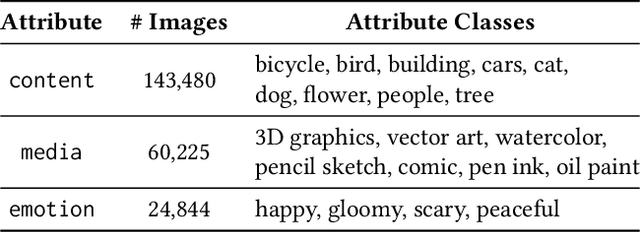


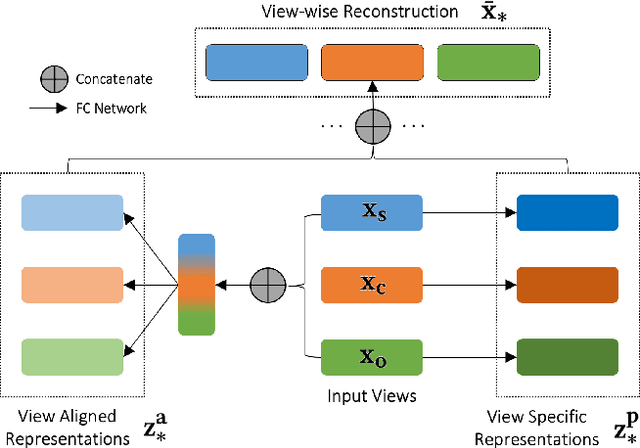
Abstract:Image search engines enable the retrieval of images relevant to a query image. In this work, we consider the setting where a query for similar images is derived from a collection of images. For visual search, the similarity measurements may be made along multiple axes, or views, such as style and color. We assume access to a set of feature extractors, each of which computes representations for a specific view. Our objective is to design a retrieval algorithm that effectively combines similarities computed over representations from multiple views. To this end, we propose a self-supervised learning method for extracting disentangled view-specific representations for images such that the inter-view overlap is minimized. We show how this allows us to compute the intent of a collection as a distribution over views. We show how effective retrieval can be performed by prioritizing candidate expansion images that match the intent of a query collection. Finally, we present a new querying mechanism for image search enabled by composing multiple collections and perform retrieval under this setting using the techniques presented in this paper.
Generating Compositional Color Representations from Text
Sep 22, 2021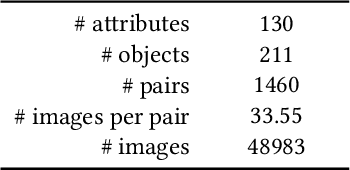

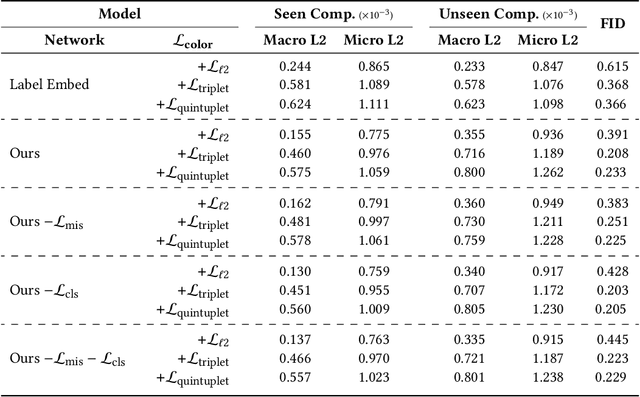
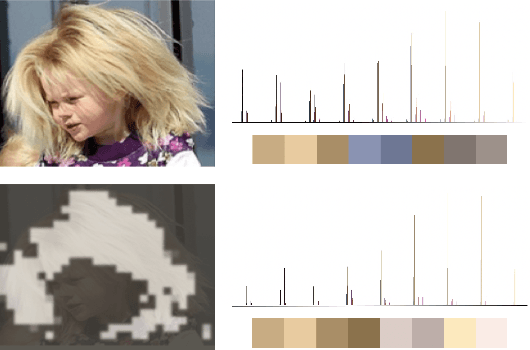
Abstract:We consider the cross-modal task of producing color representations for text phrases. Motivated by the fact that a significant fraction of user queries on an image search engine follow an (attribute, object) structure, we propose a generative adversarial network that generates color profiles for such bigrams. We design our pipeline to learn composition - the ability to combine seen attributes and objects to unseen pairs. We propose a novel dataset curation pipeline from existing public sources. We describe how a set of phrases of interest can be compiled using a graph propagation technique, and then mapped to images. While this dataset is specialized for our investigations on color, the method can be extended to other visual dimensions where composition is of interest. We provide detailed ablation studies that test the behavior of our GAN architecture with loss functions from the contrastive learning literature. We show that the generative model achieves lower Frechet Inception Distance than discriminative ones, and therefore predicts color profiles that better match those from real images. Finally, we demonstrate improved performance in image retrieval and classification, indicating the crucial role that color plays in these downstream tasks.
 Add to Chrome
Add to Chrome Add to Firefox
Add to Firefox Add to Edge
Add to Edge